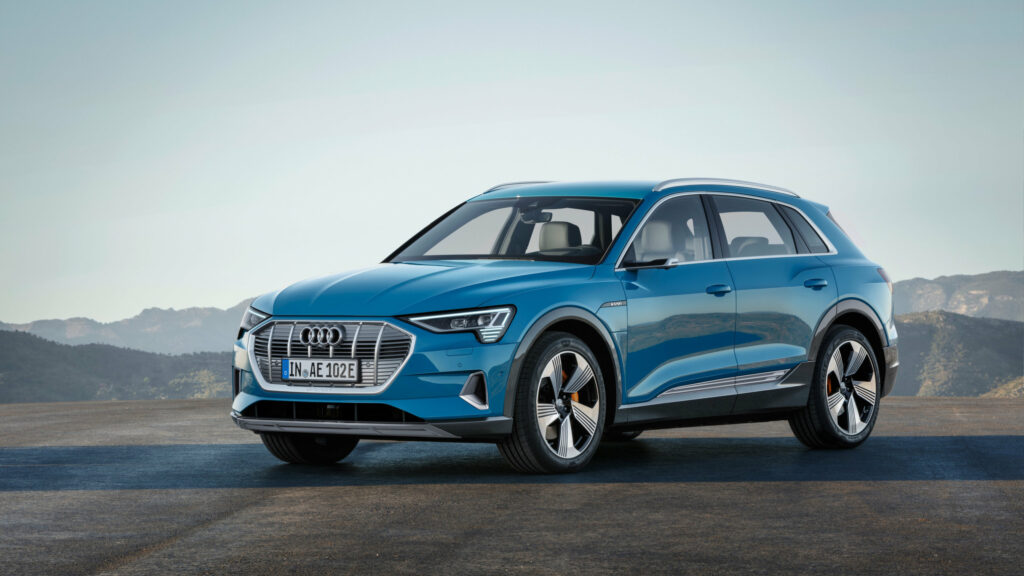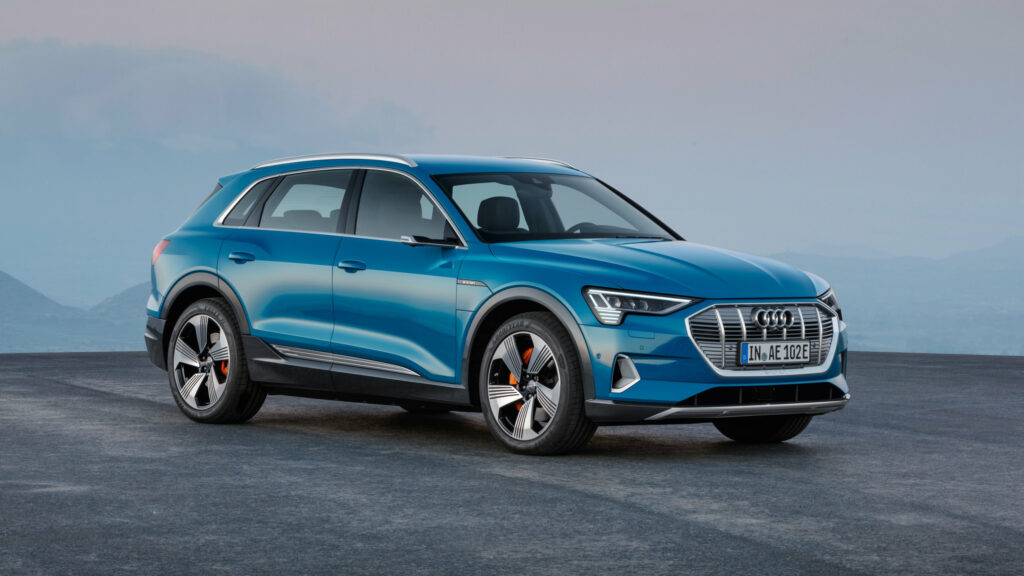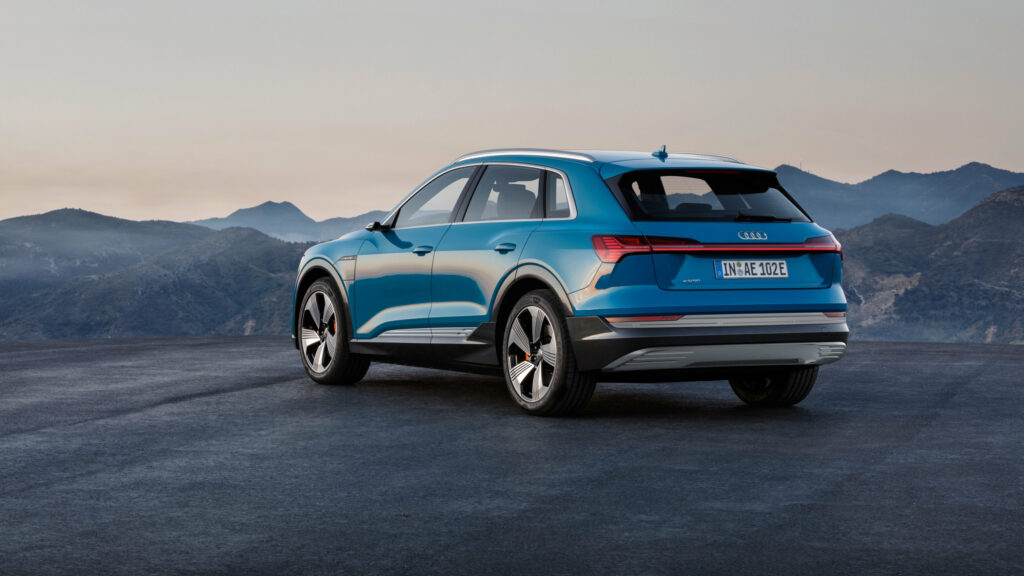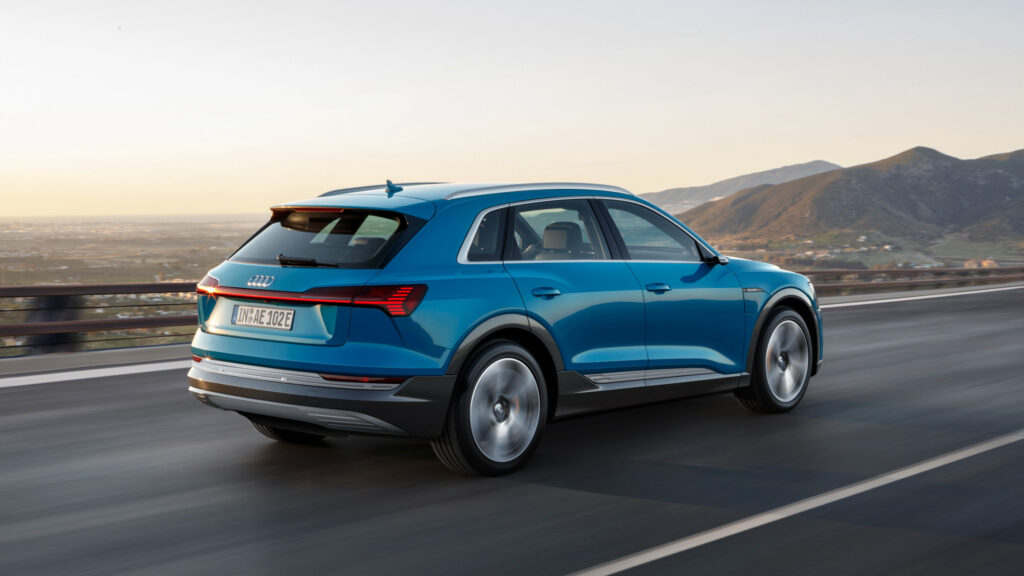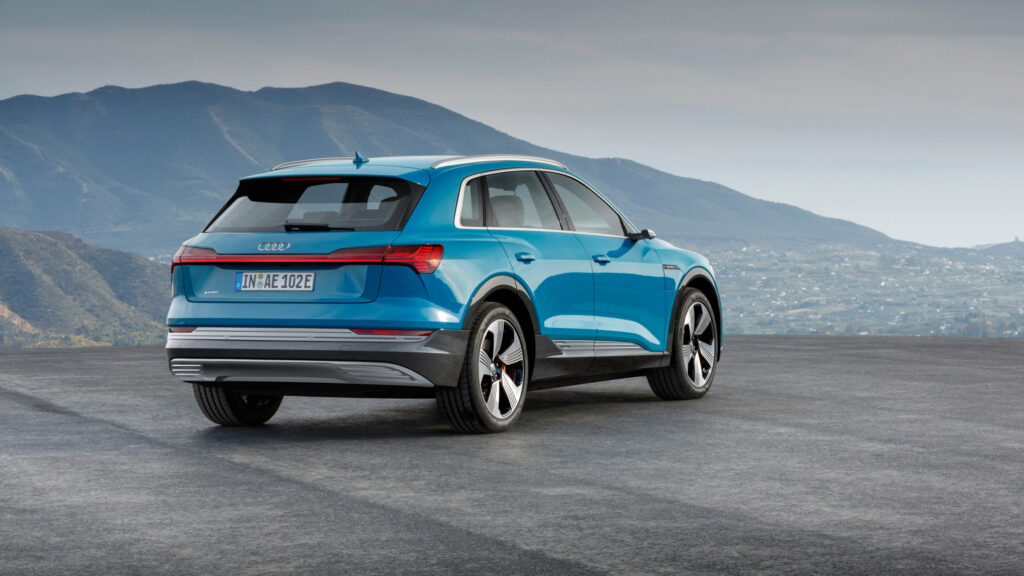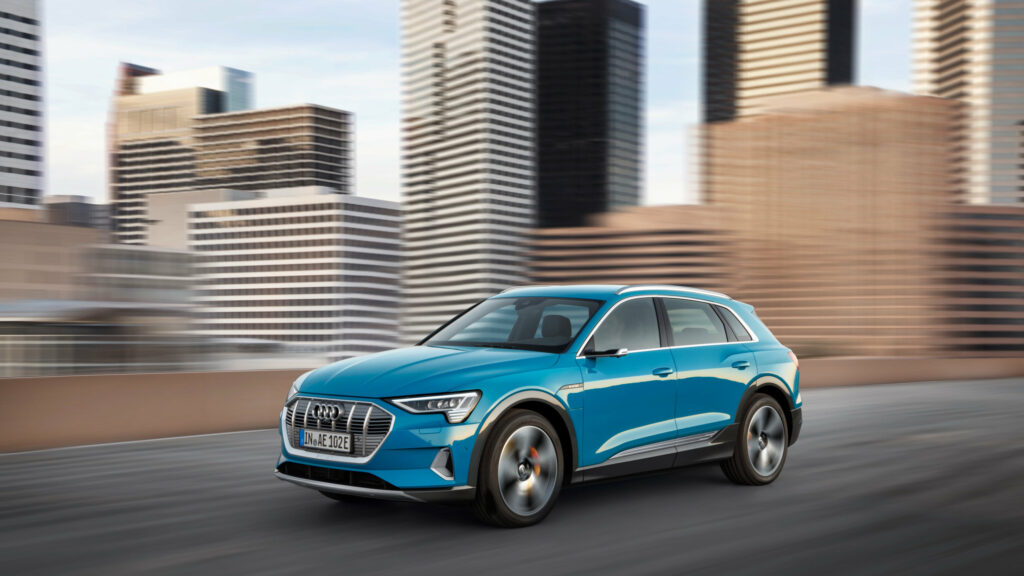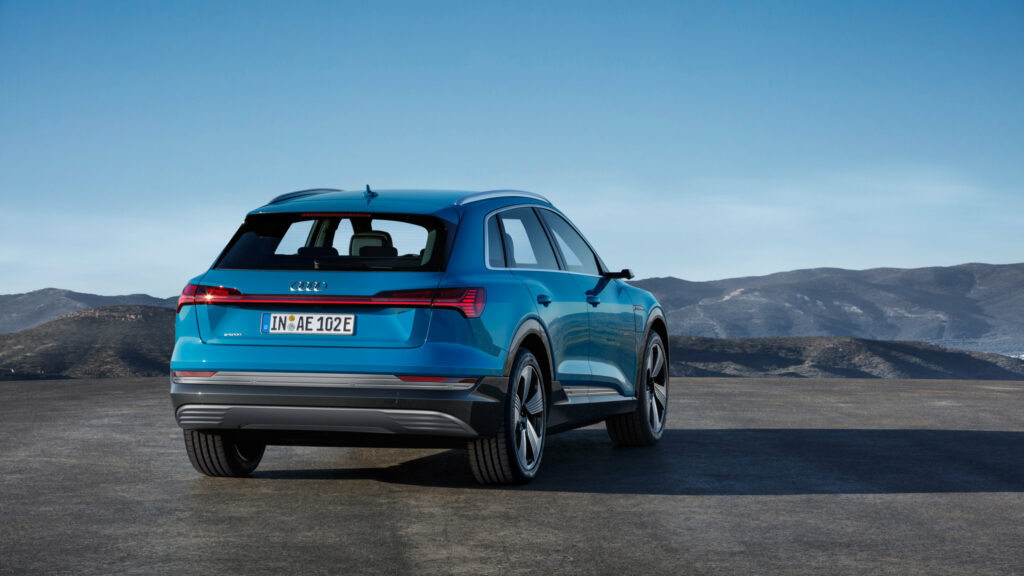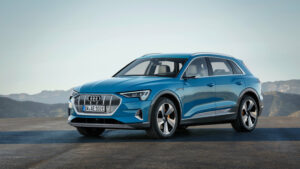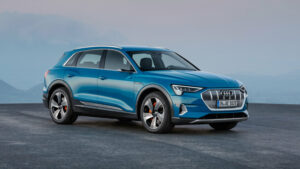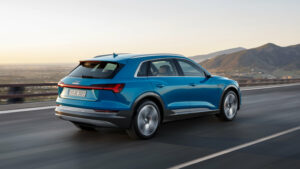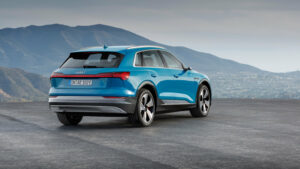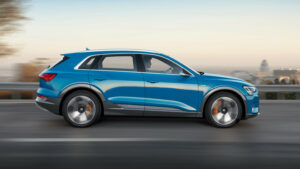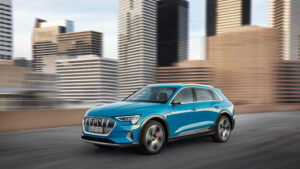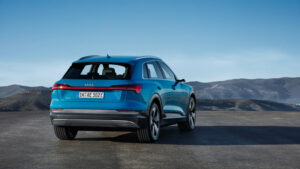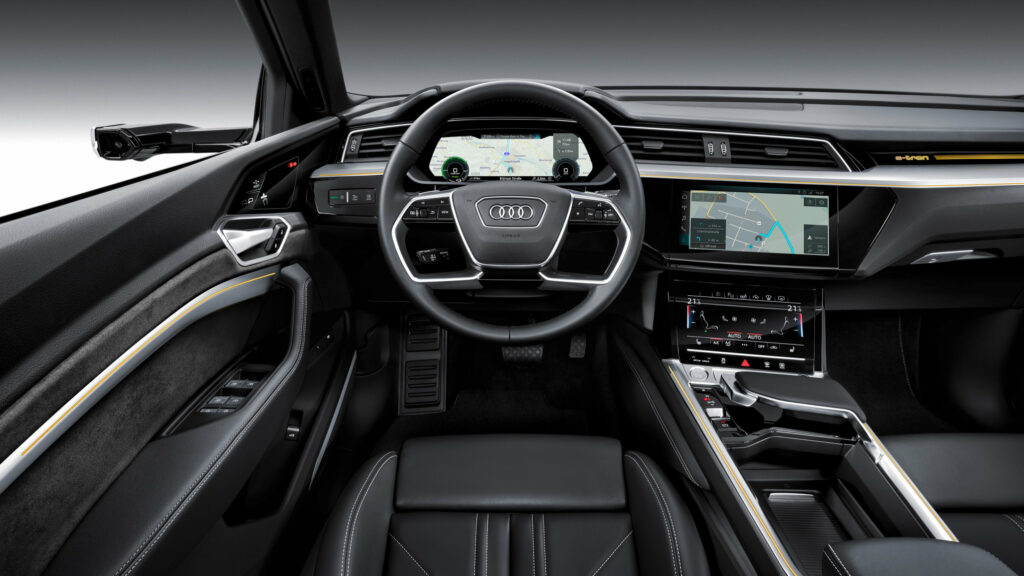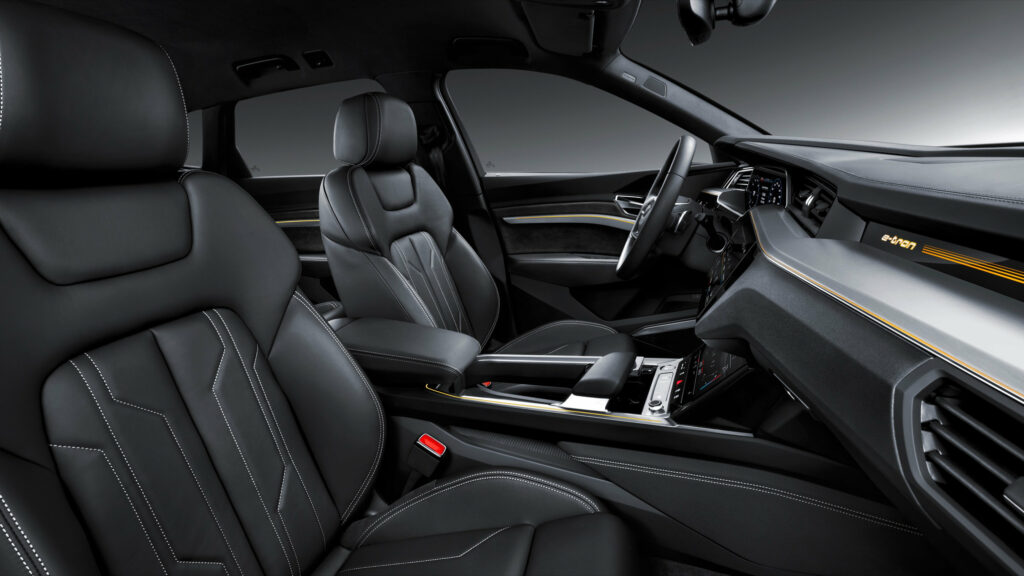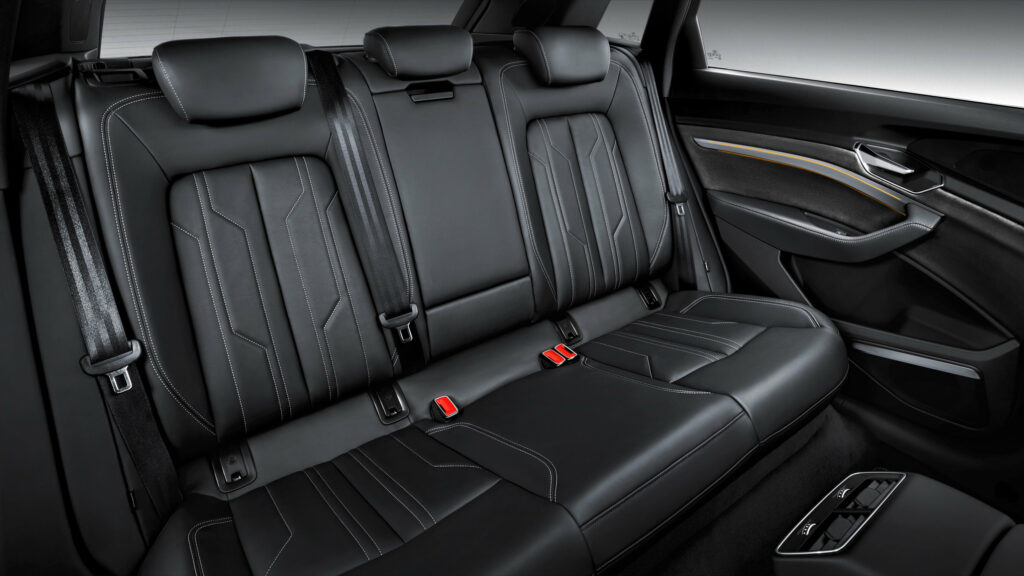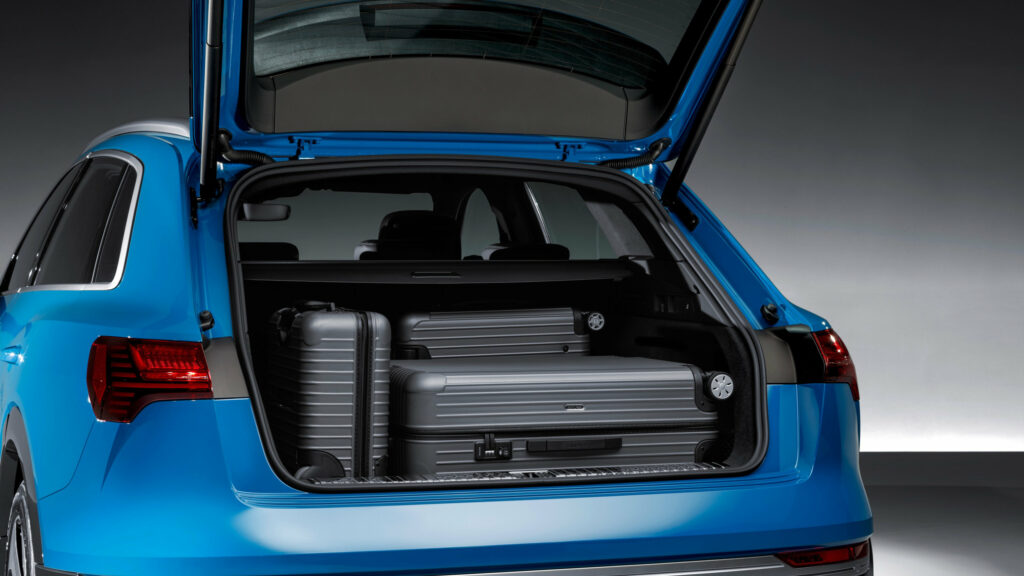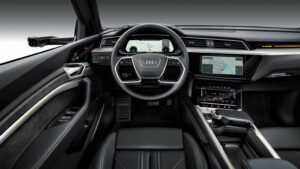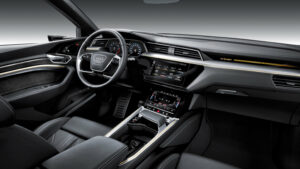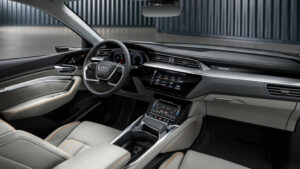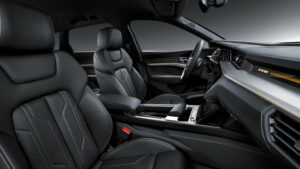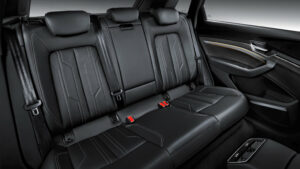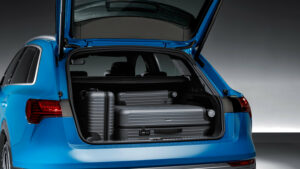Audi e-tron 55 quattro
The Audi e-tron 55 quattro is an electric crossover for sports, family, and leisure that has enough space for five passengers and a solid amount of cargo space.
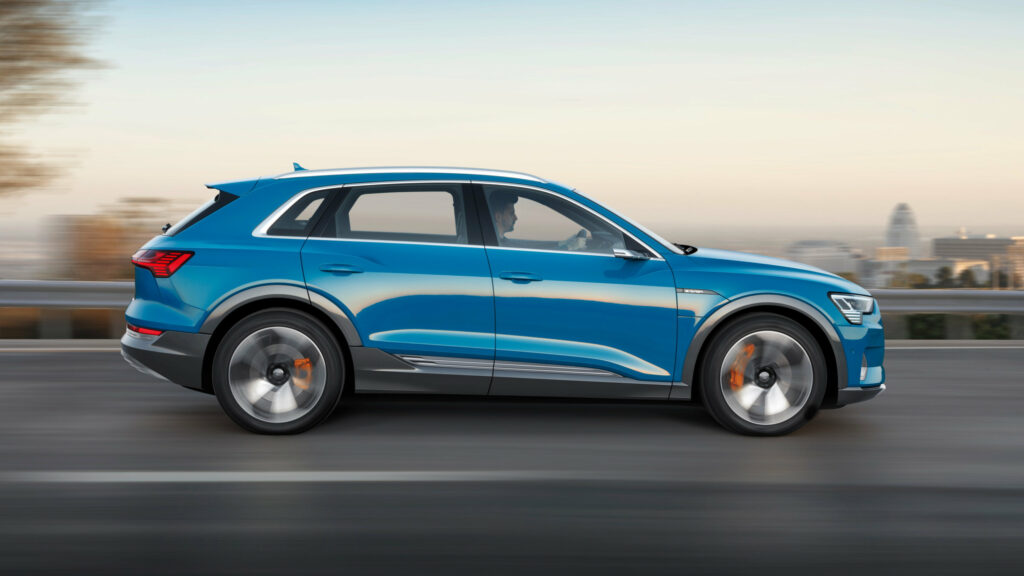
Audi e-tron 55 quattro electric crossover design
The Audi e-tron 55 quattro reflects Audi’s new design foundation – a stylistic focus on refined aerodynamic detailing in which everything should emphasize the electric nature of the car. The first element that catches the eye is the hexagonal grille with an octagonal design and vertical struts. Also standing out are the LED optics, where a special element is the display of daytime running lights in a format resembling a charge level indicator – a solution implemented directly in the headlights for the first time.
Another important design element is the car’s continuous shoulder line that extends from the headlights, along the sides, to the taillights and gives the Audi e-tron a sense of massiveness and power.
At the stern of the electric car, a long roof spoiler and a wide diffuser emphasize the sporty look. One of the distinctive elements of the e-tron quattro is the light strip connecting the rear LED lights.
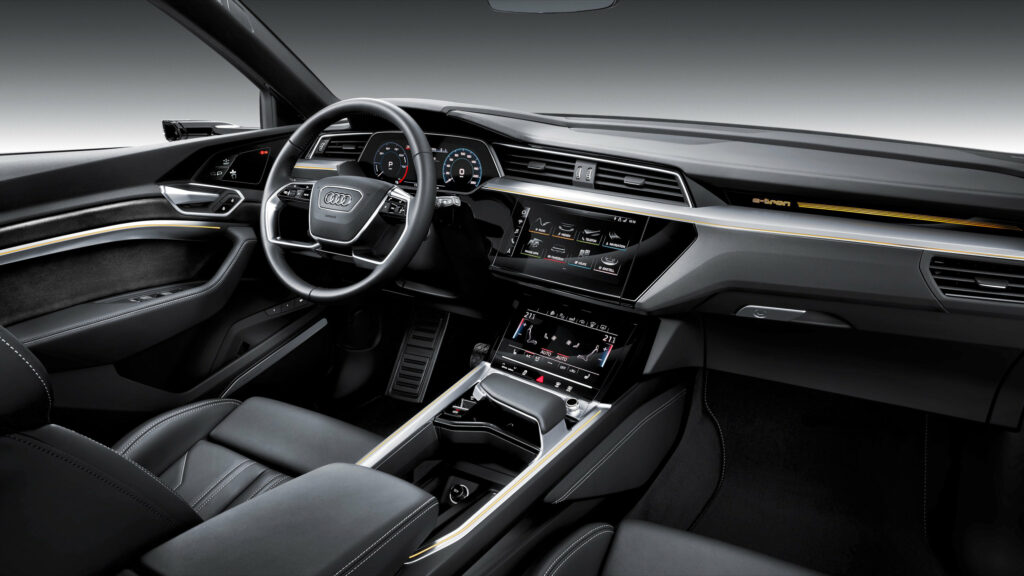
Electric all-wheel drive and regeneration system
The manufacturer installed two asynchronous motors (ASM) on the Audi e-tron quattro, located on the front and rear axle, thereby providing the electric crossover with all-wheel drive.
The power output of the rear electric motor is 140 kW (165 kW in S mode), and the front one is 125 kW (135 kW in S mode). Together, they produce 265 kW at 561 N⋅m of torque in D mode and up to 300 kW at 664 N⋅m in S mode.
Audi e-tron 55 quattro accelerates to 100 km/h in 6.6 seconds and 5.7 seconds in S mode and the maximum speed of the electric car is electronically limited to 200 km/h. It is important to note that when traveling at low speeds Audi e-tron is driven by the rear electric motor, switching on the front one only when switching to active drive.
The Audi e-tron quattro uses an innovative recuperation system covering both electric motors. The system is responsible for 30% of the e-tron’s range depending on conditions, terrain, and driving style. The electric crossover can recover energy in two ways: through rolling recovery when the driver releases the accelerator pedal or by regenerating the brakes by depressing the brake pedal. When the brake pedal is depressed, the electronic control unit instantly calculates how much pressure the system requires for a particular braking process, and the high-performance electric motor provides the necessary energy.
Innovative battery and charging for the Audi e-tron quattro
A completely new battery system has been developed for the Audi e-Tron. The electric car, it is located under the bottom almost in the center of the car, its dimensions are 2.28 m long, 1.63 m wide, and 34 centimeters high. It is composed of 36 modules of cells in aluminum square housings, with a two-level arrangement. Each module has a flexible outer sheath of aluminum-coated polymer. The battery is designed for 95 kW⋅h of capacity and operates at a nominal voltage of 396 V. The battery capacity is sufficient for 400 km of range according to the WLTP standard.
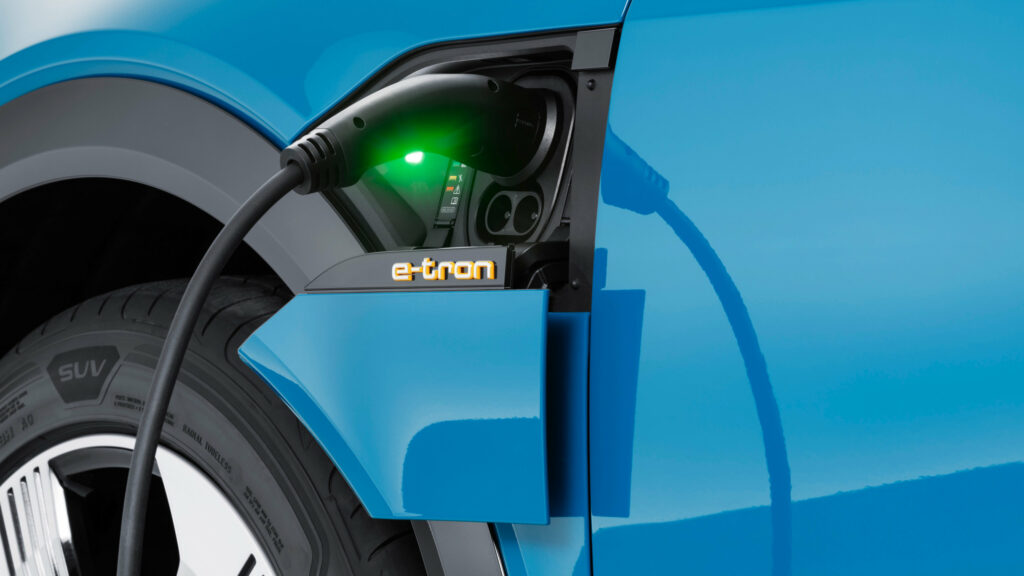
The Audi e-tron quattro battery uses a gel that is contained under each cell to cool the battery and performs heat transfer between them and the cooling system by evenly transferring waste heat to the coolant through the battery case.
The cooling system not only removes heat, it also uses it to store up to three kilowatts of energy, which is then used to heat the interior.
The Audi e-tron quattro has AC and DC charging capabilities through SAE J1772 and CCS ports. In addition, the crossover debuts as an electric car with charging capability on high-speed DC stations with up to 150 kW of power. In this mode, the Audi e-tron Quattro battery can be charged in 30 minutes to 80% of its capacity.
| Performance | |
| Acceleration 0 – 100 km/h | 5.7 sec |
| Top Speed | 200 km/h |
| Electric Range | 365 km |
| Total Power | 300 kW (408 PS) |
| Total Torque | 664 Nm |
| Drive | AWD |
| Battery and Charging | |
| Battery Capacity | 95.0 kWh |
| Battery Useable | 86.5 kWh |
| Europe | |
| Charge Port | Type 2 |
| Port Location | Left Side – Front |
| Port Location 2 | Right Side – Front |
| Charge Power | 11 kW AC |
| Charge Time (0->365 km) | 9h15m |
| Charge Speed | 39 km/h |
| Fastcharge Port | CCS |
| FC Port Location | Left Side – Front |
| FC Port Location 2 | – |
| Fastcharge Power (max) | 155 kW DC |
| Fastcharge Time (37->292 km) | 26 min |
| Fastcharge Speed | 590 km/h |
| Available as an option Energy Consumption | |
| EVDB Real Range | |
| Range | 365 km |
| Vehicle Consumption | 237 Wh/km |
| CO2 Emissions | 0 g/km |
| Vehicle Fuel Equivalent | 2.7 l/100km |
| WLTP Ratings (TEL) | |
| Range | 441 km |
| Rated Consumption | 222 Wh/km |
| Vehicle Consumption | 196 Wh/km |
| CO2 Emissions | 0 g/km |
| Rated Fuel Equivalent | 2.5 l/100km |
| Vehicle Fuel Equivalent | 2.2 l/100km |
| WLTP Ratings (TEH) | |
| Range | 369 km |
| Rated Consumption | 261 Wh/km |
| Vehicle Consumption | 234 Wh/km |
| CO2 Emissions | 0 g/km |
| Rated Fuel Equivalent | 2.9 l/100km |
| Vehicle Fuel Equivalent | 2.6 l/100km |
| Real Energy Consumption between 168 – 326 Wh/km | |
| City – Cold Weather | 237 Wh/km |
| Highway – Cold Weather | 326 Wh/km |
| Combined – Cold Weather | 279 Wh/km |
| City – Mild Weather | 168 Wh/km |
| Highway – Mild Weather | 262 Wh/km |
| Combined – Mild Weather | 211 Wh/km |
|
Energy use for each trip will vary considerably depending on the driver and the conditions. Therefore, we have provided a range of estimates which can be useful in developing an understanding of the potential benefits of this technology. |
|
| Safety Rating | |
| Adult Occupant | 91% |
| Child Occupant | 85% |
| Rating Year | 2019 |
| Vulnerable Road Users | 71% |
| Safety Assist | 76% |
| Dimensions and Weight | |
| Length | 4901 mm |
| Width | 1935 mm |
| Width with mirrors | 2192 mm |
| Height | 1616 mm |
| Wheelbase | 2928 mm |
| Weight Unladen (EU) | 2595 kg |
| Gross Vehicle Weight (GVWR) | 3170 kg |
| Max. Payload | 650 kg |
| Cargo Volume | 660 L |
| Cargo Volume Max | 1725 L |
| Cargo Volume Frunk | No Data |
| Roof Load | 75 kg |
| Tow Hitch Possible | Yes |
| Towing Weight Unbraked | 750 kg |
| Towing Weight Braked | 1800 kg |
| Vertical Load Max | 80 kg |
| Miscellaneous | |
| Seats | 5 people |
| Isofix | Yes, 3 seats |
| Turning Circle | 12.2 m |
| Platform | VW MLB |
| Car Body | SUV |
| Segment | JE – Executive |
| Roof Rails | Yes |
| EV Dedicated Platform | No |
Home and Destination Charging (0 -> 100%)
A public charging station is required to use the highest possible charging rate. The EVSE/charging station’s charging capacity affects how long it takes to fully charge the battery. The table below shows all possible options for fully charging the Audi e-tron 55 quattro.
In Europe, plugging an electric car into an outlet is often as easy as plugging it into a household outlet, but there are differences from country to country. The table below shows the different ways to charge the Audi e-tron 55 quattro, but in some countries some chargers may not be available.
Type 2 (Mennekes – IEC 62196)

| Charging Point | Max. Power | Power | Time | Rate |
| Wall Plug (2.3 kW) | 230V / 1x10A | 2.3 kW | 44h15m | 8 km/h |
| 1-phase 16A (3.7 kW) | 230V / 1x16A | 3.7 kW | 27h30m | 13 km/h |
| 1-phase 32A (7.4 kW) | 230V / 1x32A | 7.4 kW | 13h45m | 27 km/h |
| 3-phase 16A (11 kW) | 400V / 3x16A | 11 kW | 9h15m | 39 km/h |
| 3-phase 32A (22 kW) | 400V / 3x16A | 11 kW | 9h15m | 39 km/h |
Fast Charging (10 -> 80%)
If you want to enjoy driving an electric car, one of the most important features to consider is the number of miles per hour the car can travel while charged. This is called the “range” of the car. All electric cars have a certain range, even if they are 100% charged. This is because they do not have an internal combustion engine to lean on if you need to drive a long distance.
Max. Power: The maximum power provided by the charging point
Avg. Power: The average power provided by the charging point during a session of 10% to 80%.
Time: the time it takes to charge from 10% to 80%
Speed: the average charging rate during the session of 10% to 80%
Combined Charging System (CCS Combo 2)
| Charging Point | Max. Power | Avg. Power | Time | Rate |
| CCS (50 kW DC) | 50 kW | 50 kW | 76 min | 200 km/h |
| CCS (175 kW DC) | 155 kW | 146 kW | 26 min | 590 km/h |
| CCS (350 kW DC) | 155 kW | 146 kW | 26 min | 590 km/h |
| Brand | Audi |
| Model | e-tron 55 quattro |
| Body Style | suv |
| Car Engine | electric |
| Motor power | 300 |
| Maximum Torque, Nm | 664 |
| Battery Energy, kWh | 95.0 |
| Power reserve (NEDC/EPA/WLTP), km | - / - / 515 |
| Level Charging (230/400/DC), hours | - / - / 0.26 |
| Electrical Acceleration, 0-100 km/h (0-62.1 mph) in sec | 5.7 |
| Top Speed, km/h | 200 |
